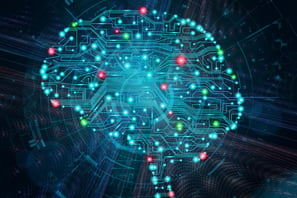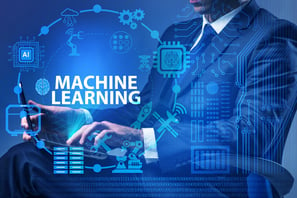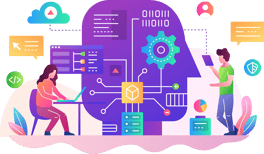Demystifying Artificial Intelligence and Machine Learning: A Beginner's Guide
Artificial Intelligence (AI) simulates human intelligence in machines, enabling tasks like problem-solving and decision-making. Machine Learning (ML) is a subset of AI where algorithms learn from data to make predictions or decisions without explicit programming.
Vinay
5/4/20246 min read


Introduction:
Understanding Artificial Intelligence:
Artificial Intelligence refers to the simulation of human intelligence in machines that are programmed to mimic cognitive functions such as learning, problem-solving, and decision-making. AI can be categorized into two types:
Narrow AI (Weak AI): Narrow AI is designed to perform specific tasks or solve particular problems within a limited domain. Examples include virtual assistants like Siri, recommendation systems, and facial recognition software.
General AI (Strong AI): General AI refers to AI systems with the ability to understand, learn, and apply knowledge across a wide range of tasks, similar to human intelligence. General AI remains a theoretical concept and is yet to be achieved.
Understanding Machine Learning:
Machine Learning is a subset of AI that focuses on the development of algorithms that enable computers to learn from data and make predictions or decisions without being explicitly programmed. ML algorithms can be categorized into three types:
Applications of AI and ML:
AI and ML have numerous applications across various industries, revolutionizing how tasks are performed and problems are solved. Some notable applications include:
Future Perspectives:
The field of AI and ML is rapidly evolving, with continuous advancements in algorithms, computing power, and data availability. As technology progresses, we can expect AI and ML to play an increasingly prominent role in various aspects of our lives, driving innovation and reshaping industries.
One of the Best Platform to Learn AI & ML:
The Mumbai Coding Lab: designed for students of different age groups. Including Future Ready courses like ScratchJr & Scratch, Raspberry Pi, Arduino, Artificial Intelligence and Machine Learning & much more....,These hands-on robotics kits introduce students to robotics and coding concepts in a fun and accessible way, promoting creativity and experimentation.
The most important thing parents should look for while searching for robotics and coding schools is physical accessible distance and flexibility of physical one-to-one and online/virtual classes. At TMCL we are happy to offer both Physical one-to-one and Online classes as they prefer. Our Lab is located in Velentine Apartment Building in Malad East near Oberoi Mall.
Website Link: https://themumbaicodinglab.in/
The most important factor while choosing any after-school program like robotics and coding is affordability, the TMCL programs are easily affordable to anyone.
Conclusion:
Artificial Intelligence and Machine Learning are transformative technologies that hold immense potential to solve complex problems and improve efficiency across diverse domains. In this blog post, we've explored the concepts of AI and ML, their applications, and their implications for the future. Whether you're a beginner or an experienced professional, embracing AI and ML opens up a world of opportunities to innovate and create solutions that positively impact society.
Artificial Intelligence (AI) and Machine Learning (ML) have become buzzwords in the tech industry, but understanding what they entail can be daunting for beginners. In this blog post, we'll unravel the mysteries surrounding AI and ML, explore their concepts, applications, and provide insights into how they're shaping the future of technology.


Supervised Learning: In supervised learning, the model is trained on labeled data, where each input is associated with the correct output. The goal is to learn a mapping function from input to output.
Unsupervised Learning: Unsupervised learning involves training the model on unlabeled data, where the algorithm tries to identify patterns or structure within the data without guidance. Clustering and dimensionality reduction are common tasks in unsupervised learning.
Reinforcement Learning: Reinforcement learning is a type of ML where an agent learns to make decisions by interacting with an environment. The agent receives feedback in the form of rewards or penalties, allowing it to learn optimal behavior through trial and error.


Healthcare: AI is used for medical image analysis, drug discovery, personalized treatment plans, and predictive analytics for disease diagnosis.
Finance: ML algorithms are employed for fraud detection, algorithmic trading, credit scoring, and risk management in the financial sector.
Transportation: AI powers self-driving cars, traffic management systems, route optimization, and predictive maintenance in transportation and logistics.
Retail: AI-driven recommendation engines, demand forecasting, inventory management, and personalized marketing enhance the retail experience for consumers.




Introduction:
Understanding Artificial Intelligence:
Artificial Intelligence refers to the simulation of human intelligence in machines that are programmed to mimic cognitive functions such as learning, problem-solving, and decision-making. AI can be categorized into two types:
Narrow AI (Weak AI): Narrow AI is designed to perform specific tasks or solve particular problems within a limited domain. Examples include virtual assistants like Siri, recommendation systems, and facial recognition software.
General AI (Strong AI): General AI refers to AI systems with the ability to understand, learn, and apply knowledge across a wide range of tasks, similar to human intelligence. General AI remains a theoretical concept and is yet to be achieved.
Understanding Machine Learning:
Machine Learning is a subset of AI that focuses on the development of algorithms that enable computers to learn from data and make predictions or decisions without being explicitly programmed. ML algorithms can be categorized into three types:
Applications of AI and ML:
AI and ML have numerous applications across various industries, revolutionizing how tasks are performed and problems are solved. Some notable applications include:
Future Perspectives:
The field of AI and ML is rapidly evolving, with continuous advancements in algorithms, computing power, and data availability. As technology progresses, we can expect AI and ML to play an increasingly prominent role in various aspects of our lives, driving innovation and reshaping industries.
One of the Best Platform to Learn AI & ML:
The Mumbai Coding Lab: designed for students of different age groups. Including Future Ready courses like ScratchJr & Scratch, Raspberry Pi, Arduino, Artificial Intelligence and Machine Learning & much more....,These hands-on robotics kits introduce students to robotics and coding concepts in a fun and accessible way, promoting creativity and experimentation.
The most important thing parents should look for while searching for robotics and coding schools is physical accessible distance and flexibility of physical one-to-one and online/virtual classes. At TMCL we are happy to offer both Physical one-to-one and Online classes as they prefer. Our Lab is located in Velentine Apartment Building in Malad East near Oberoi Mall.
Website Link: https://themumbaicodinglab.in/
The most important factor while choosing any after-school program like robotics and coding is affordability, the TMCL programs are easily affordable to anyone.
Conclusion:
Artificial Intelligence and Machine Learning are transformative technologies that hold immense potential to solve complex problems and improve efficiency across diverse domains. In this blog post, we've explored the concepts of AI and ML, their applications, and their implications for the future. Whether you're a beginner or an experienced professional, embracing AI and ML opens up a world of opportunities to innovate and create solutions that positively impact society.
Artificial Intelligence (AI) and Machine Learning (ML) have become buzzwords in the tech industry, but understanding what they entail can be daunting for beginners. In this blog post, we'll unravel the mysteries surrounding AI and ML, explore their concepts, applications, and provide insights into how they're shaping the future of technology.


Supervised Learning: In supervised learning, the model is trained on labeled data, where each input is associated with the correct output. The goal is to learn a mapping function from input to output.
Unsupervised Learning: Unsupervised learning involves training the model on unlabeled data, where the algorithm tries to identify patterns or structure within the data without guidance. Clustering and dimensionality reduction are common tasks in unsupervised learning.
Reinforcement Learning: Reinforcement learning is a type of ML where an agent learns to make decisions by interacting with an environment. The agent receives feedback in the form of rewards or penalties, allowing it to learn optimal behavior through trial and error.


Healthcare: AI is used for medical image analysis, drug discovery, personalized treatment plans, and predictive analytics for disease diagnosis.
Finance: ML algorithms are employed for fraud detection, algorithmic trading, credit scoring, and risk management in the financial sector.
Transportation: AI powers self-driving cars, traffic management systems, route optimization, and predictive maintenance in transportation and logistics.
Retail: AI-driven recommendation engines, demand forecasting, inventory management, and personalized marketing enhance the retail experience for consumers.


